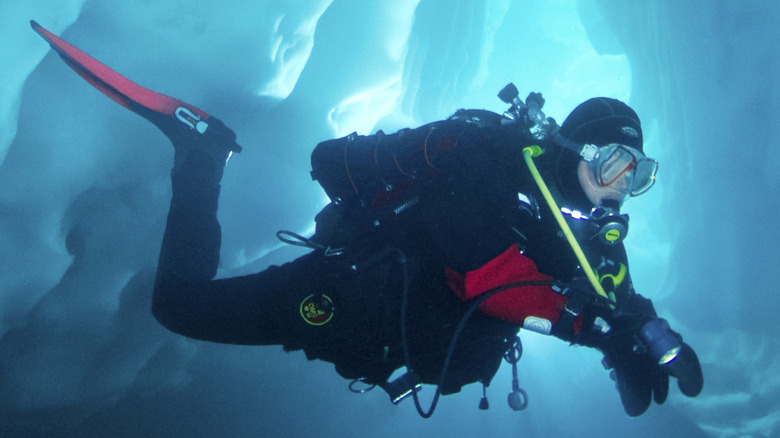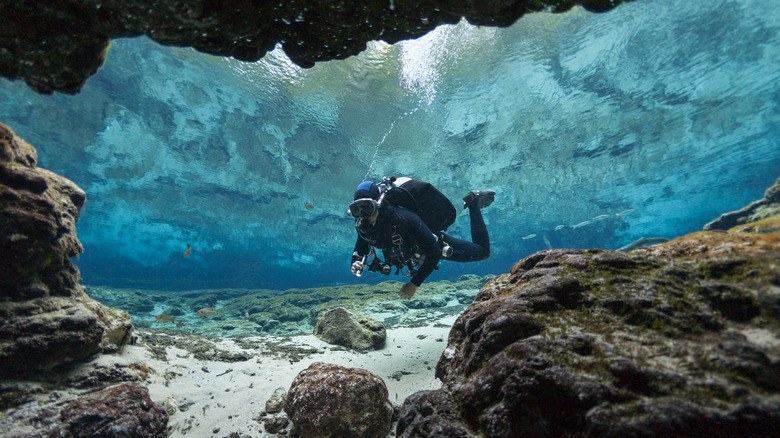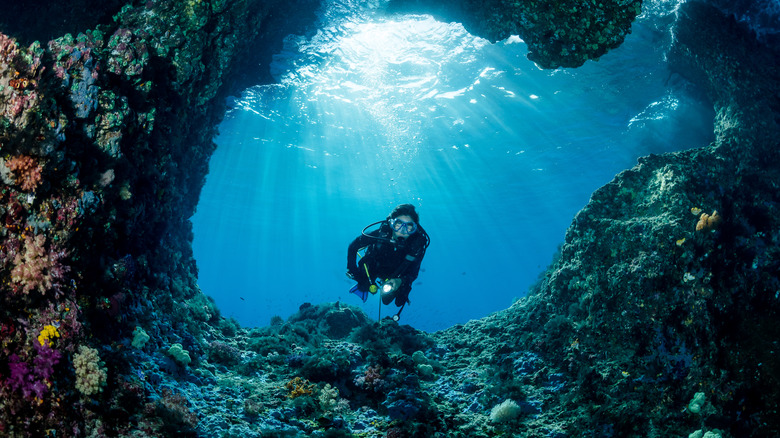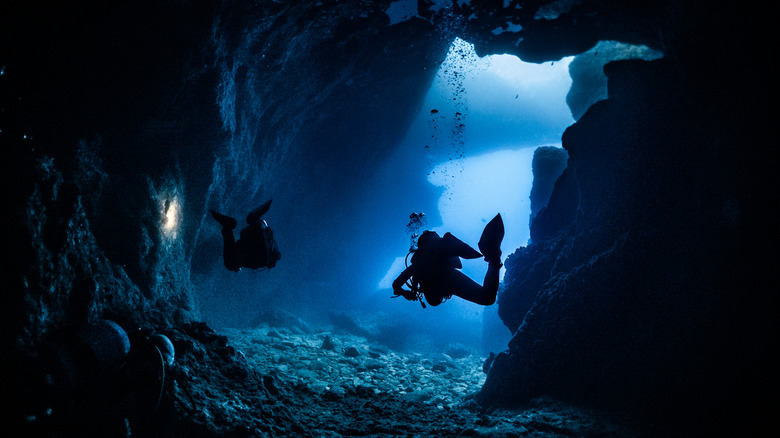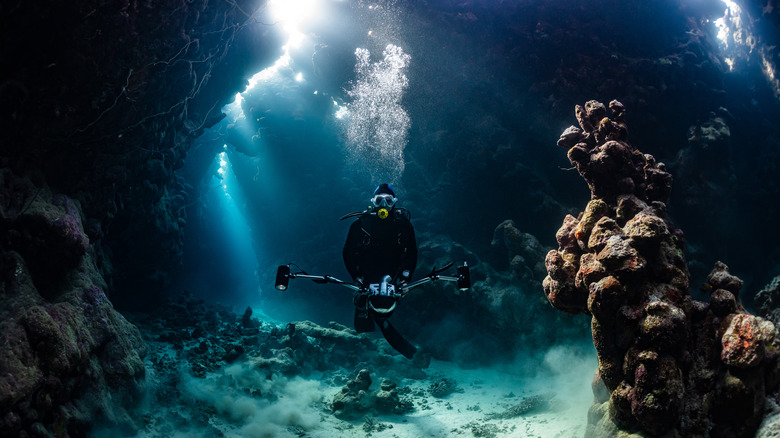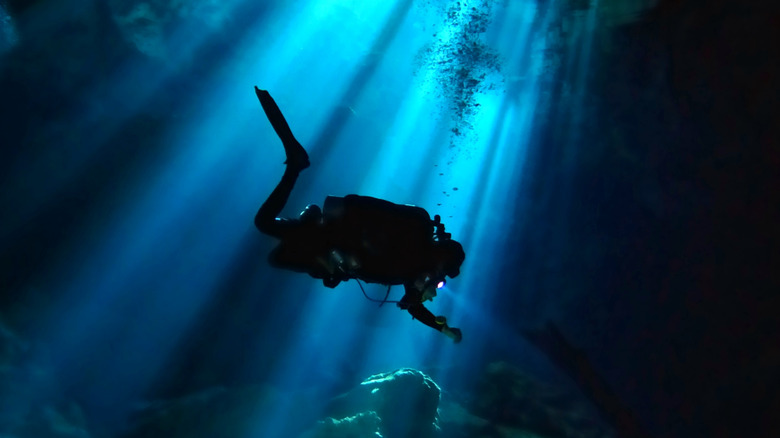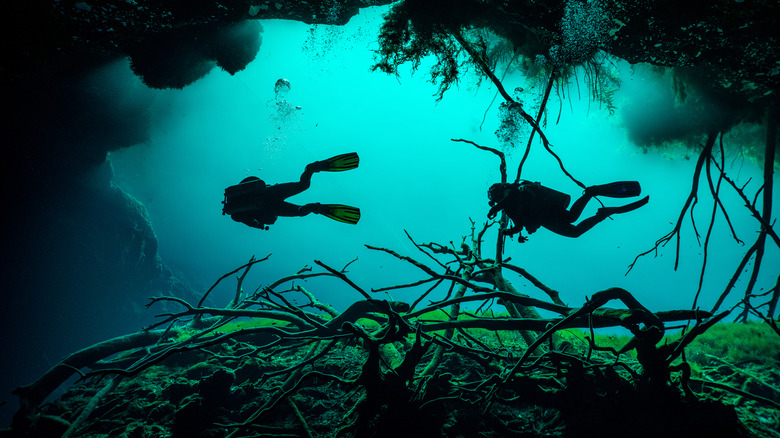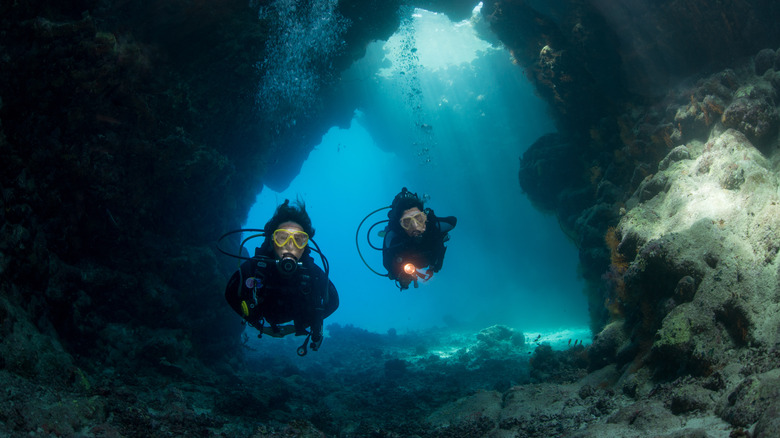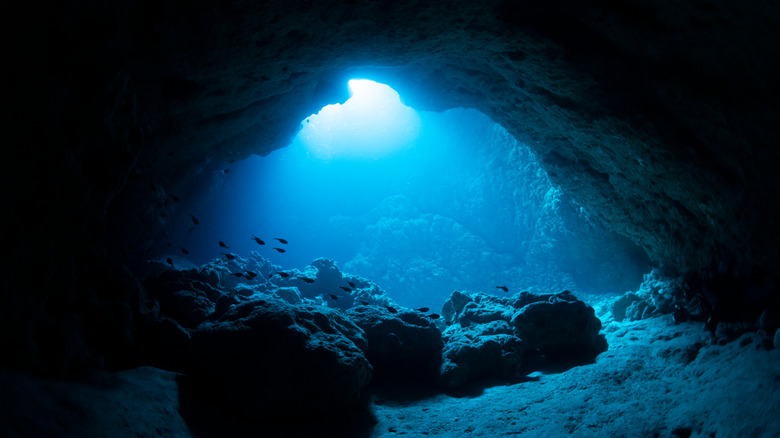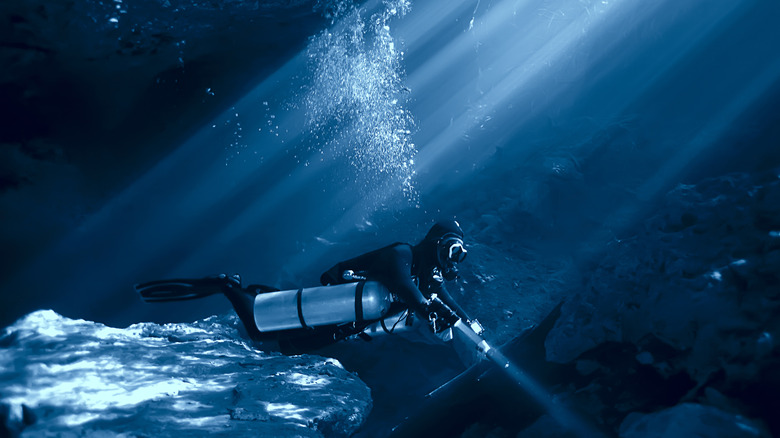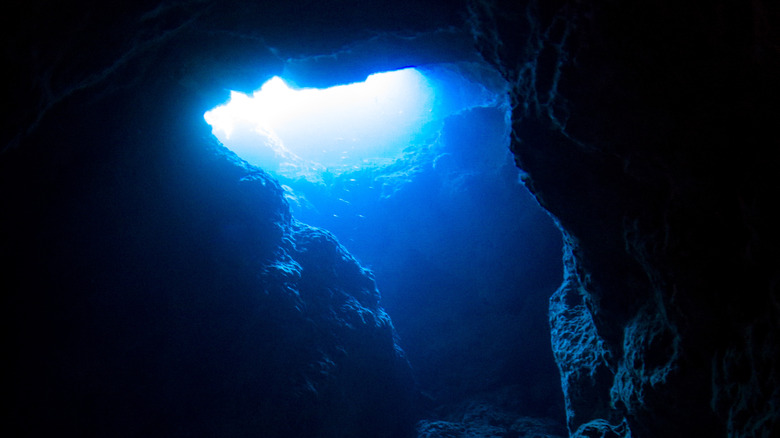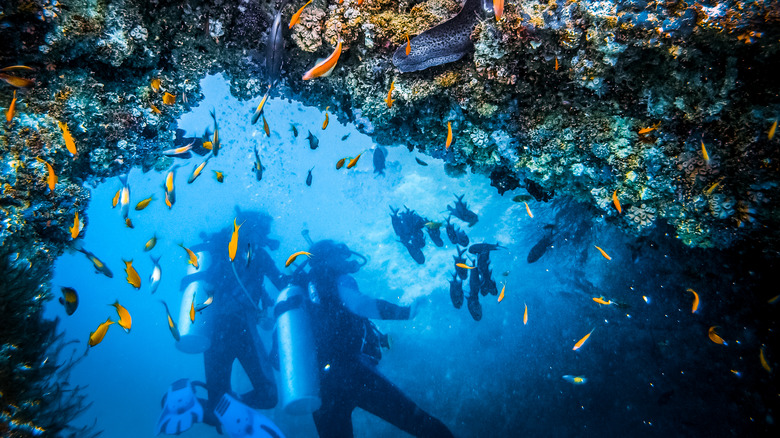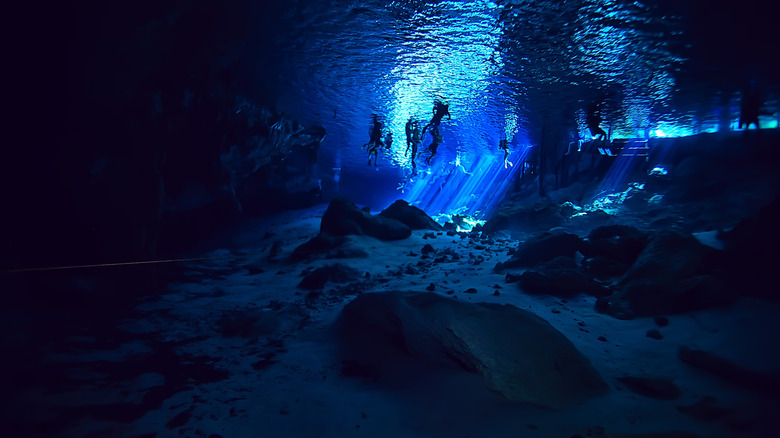The Dark Truth About Cave Diving
Cave diving is a sport unlike any other. According to the Conversation, it's considered to be an extremely dangerous activity on account of the sheer number of risks that are associated with it. Several things can go awry when you're exploring a dark cave underwater, such as equipment failure, losing your way, or trying to deal with close to zero visibility while making your way to the exit. One thing is clear: Cave diving definitely not a sport for the faint-hearted. And yet, the sport still has plenty of fans who look forward to every dive with unbridled enthusiasm.
But cave diving isn't always recreational. The risky activity is also an important tool for scientists to learn more about underwater caves and marine life.
Of course, only those who are well-trained and confident in their abilities should go cave diving, and it's not enough to just have a scuba-diving certificate. As per the Atlantic, scuba diving and cave diving are two entirely different experiences. Robert Laird, co-founder of International Underwater Cave Rescue and Recovery, told the Atlantic, "Experienced open-water divers, unfortunately, think that they are qualified to dive into caves, but they're not. There have been lots of extremely experienced open-water divers that have died in caves."
Want to know more about this dangerous activity? This is the dark truth about cave diving.
Cave diving is very dangerous
According to the Christian Science Monitor, divers first began exploring underwater cave systems in the mid-1960s, when new scuba apparatus allowed them to dive deeper and for longer than before. But cave diving is simply a lot riskier than open-water scuba diving and other similar underwater activities.
Robert Laird told the Atlantic, "The one thing that kills divers more than anything else is panic. It can start with a small thing, like suddenly you see bubbles coming off a hose," he explained, adding that a brain experiencing panic tends to dismiss rational arguments, and it can become a lot harder to figure out how to swim to safety.
As per Laird, a diver who is in that state of mind struggles to think clearly and plan an escape route. In fact, they may even end up going deeper into the cave without realizing it. He explained, "When you're panicked, there's absolutely no logic. There's no reasoning. There's no logical method of thinking."
In an interview with Atlas Explorer, Jill Heinerth, an underwater photographer and explorer-in-residence for the Royal Canadian Geographical Society, said that cave diving is one sport that has been often been understood through accident analysis, with scientists studying fatal cases to understand what happened to help others prepare for future cave dives. She said that five rules were developed from this: have proper training, have a guide line, reserve enough air, have proper lights, and don't go too deep.
Cave diving has unknown elements
Jill Heinerth told National Geographic that the more maze-like a cave is, the tougher it can be to navigate its depths. It's also more likely to be dangerous if it's a space that leaves divers with a very limited amount of time to handle unforeseen circumstances.
In an interview with WBUR, she said that if a cave hasn't been previously explored by other divers, it's likely to have a lot of silt that can affect visibility and make things riskier for divers. Heinerth said, "Your very passage through that space and the bubbles that you make from your scuba equipment can knock that silt off the walls, the floors, the ceiling and obscure your visibility so that you can't even see when you're coming out."
As per Atlas Obscura, the lack of light in caves is a huge obstacle for divers. Thomas Iliffe, an experienced cave diver and a professor specializing in the biodiversity of salt water cave systems, said, "You're in perpetual darkness. You have to bring all your own lights." He echoed Heinerth's sentiment and said that visibility can be a huge problem and something that divers need to be mindful of. He also spoke about the dangers of diving in caves that are too deep, saying that they need to be tackled carefully.
Some people are inexplicably drawn to cave diving
Despite all the dangers, many cave divers say they feel drawn to the sport. The Cut reports that, for some, extreme sports are a spiritual experience, and they even liken the undertaking to the indescribable feeling of love. Some extreme sports enthusiasts talk about time slowing down significantly and them becoming more aware of their senses and everything around them.
Psychology professor Robert Schweitzer, from the University of Queensland, said that those who engage in extreme sports such as cave diving are not reckless risk-takers but often well-trained athletes who know what they're doing. He said, "They are highly-trained individuals with a deep knowledge of themselves... who do it to have an experience that is life-enhancing and life-changing."
Jill Heinerth told National Geographic that she feels close to nature when she goes for a dive. She said, "For me, swimming in these groundwater environments is like swimming through the veins of mother earth and the lifeblood of the planet. It's almost a spiritual reckoning."
Cave diving is a crucial research tool
Cave diving might be scary, but it's also a very important tool for researchers. As per the Christian Science Monitor, exploring the underwater world is important for scientists to learn more about underwater systems, geology, and life in the oceans, seas and lakes. Marine biologist Thomas Iliffe said that he considers cave diving to be an important part of what he does. "The animals I'm looking for occur only in this deep salt water layer in caves, and only by diving can we access this environment," he explained. "There's untapped potential here."
Jim Garey, a professor at the University of South Florida who often includes cave diving in his work, said that he doesn't go deeper than he needs to on a dive. He explained, "My goal isn't to go as far or deep into the cave as I can, it's to study what's going on in the cave." Garey acknowledged that those who need to venture deeper for their research are a lot more at risk.
Some diving locations are worse than others
Not all cave diving locations are equally risky. The Eagle's Nest cave in Florida is so dangerous that it has a warning sign, something that's meant to make those attempting to explore the cave think twice (via the Washington Post.) The sign reads: "Stop. Prevent your death. There's nothing in this cave worth dying for." There's even a picture of the grim reaper next to the words.
Eagle's Nest is maze-like and can be extremely confusing for divers trying to navigate its depths. In fact, the location is considered so risky that it was closed off to the public in the late 1990s. It was re-opened after a few changes were made by the Florida Fish and Wildlife Conservation Commission but remains a hazardous place to explore, even for experienced divers.
Despite the obvious risks, many remain enamored by Eagle's Nest. Veteran diver Larry Green said, "There's a mystique about it, because people all around the world know about this dive site, but very few people have actually dove it."
Inexperienced divers cannot be exposed to it
One thing's clear: Cave diving is most definitely not for amateur divers. Undercurrent described the sport as "like skating on a freshly frozen pond. You don't realize you're in trouble until the ice cracks." It's important to be trained and experienced to handle any unforeseen circumstances. According to the article, the majority of deaths that occur during cave diving are linked to a lack of training, but Jill Heinerth told National Geographic, "In our list of people who have passed on in cave diving accidents, it's everything from the inexperienced and untrained to the very experienced and trained cave divers."
Regardless of training level, there are intrinsic risks in cave diving. What makes this activity more risky than open-water diving is the roof over the diver's head. It's as simple as this: While scuba divers can usually get up to the surface quickly if they face a problem in the ocean, cave divers cannot do the same and have to find a way to exit the cave first. They also have to be comfortable with bad visibility, enclosed spaces and other challenges.
Cave divers have to prepare differently for their dives compared to scuba divers and have to go armed with more equipment for their own safety. Cave diving may be tempting, but it's treacherous.
You can be misunderstood
In 2013, Carlos Fonseca died while in Ginnie Spring, Florida, where he was known to be preparing to explore a cave system referred to as the Devil's Spring. Journalist and fellow diver Robert Osborne wrote in the Huffington Post about losing his friend. Before the news of Fonseca's death was announced, dive forums picked up rumors and circulated a story that he had died exploring the Devil's Spring. Osborne found the speculation about the circumstances surrounding Fonseca's demise distressing. Commenters said that Fonseca had made a "diving 101" error, and some of the statements got rather personal.
Osborne wrote, "After all if we find out that a friend or colleague has tragically died in a car accident most people don't start insulting the victim's driving skills; they understand that mistakes are a part of life and grieve for the loss."
The circumstances of Fonseca's death were unknown at the time of writing, but Osborne had several theories. He wondered whether people were scared when they read about Fonseca's fate. Or perhaps they thought themselves to be invincible and didn't like to be brought back to reality and made to think about the nature of death. Osborne also speculated that some divers were trying to make themselves look better by questioning his friend's skills.
A stunt diver was killed in Australia
In 2011, a 29-year-old stunt diver named Agnes Milowka was tragically killed while cave diving in Australia. Her body was recovered near the entrance of Tank Cave, situated near Mount Gambier in southern Australia. As per the Herald Sun, she was an exceptionally talented and experienced diver who knew what she was doing and was passionate about her sport. The Sydney Morning Herald reported that just days before her death, she told a reporter, "In this day and age when you think that everything has been found and you don't even have to get off your chair to see the world, it's amazing to think there are still places human eyes have never seen before."
Milowka knew what she was facing and had written on her website, "It would be difficult to claim that caves are completely safe. Going into caves in general carries a certain amount of risk, and then if you add water and submerge the cave then obviously the risks increase." She had explored Tank Cave several times in the past.
Milowka had worked as a stunt diver for two actors in the James Cameron film "Sanctum," in which she had to enact a diving accident that was not too different from what happened to her in real life (via Leisure Pro).
Some divers have had close calls
Some divers have been lucky to escape from incredibly difficult situations without getting hurt, even those with lots of experience. Jill Heinerth told WBUR that she decided to throw caution to the wind and explore the inside of an iceberg, something that had never been done before. She and her team made an expedition to the B-15 Iceberg in Antarctica. They swam deep into a crevasse in the iceberg and made their way through "caves" inside it before getting caught in a current. They managed to get out but soon realized how risky the exploration had been. Heinerth recalled, "And there was our iceberg — the cave that we had just been inside of — breaking into pieces, heaving up in the sea and sending these giant waves towards our boat." She realized that if they had stayed any longer, they would have died on the spot.
Heinerth said that she was glad of the experience of exploring an environment untouched by others, even though it was a nerve-wracking ordeal. It also motivated her to be a more cautious diver. She said, "Those brushes with death that made me a better, safer diver in the future."
It's hard to rescue cave divers
When it comes to cave diving, very few rescue missions ever succeed. As explained by the Guardian, by the time a person is reported as missing and expert rescue teams have reached them inside a cave system, it's usually too late.
According to the Atlantic, missions to bring back bodies of divers are can be complex. Robert Laird said that he feels that many people fail to understand that these rescue missions can be complicated to execute. "There's a lot of stuff the public doesn't really realize. Since law enforcement considers these to be crime scenes, you have to follow law-enforcement protocol," he said.
Laird also highlighted that it's important to tread carefully and be discreet because seeing the recovered body can be traumatic for families and friends and that the task of recovering a body can be traumatic for rescuers, saying that most recoveries are "pretty gruesome." He explained, "Not only is the physical task load enormous, but the mental and psychological tasks of dealing with a dead body — that most people probably couldn't do."
Divers have to be ready
Those who decide to explore cave diving need to brace themselves for an exhaustive process every time they go on an adventure. Jill Heinerth has said that she completely checks her gear before each dive (via WBUR) to ensure everything is in good working order. Heinerth also allows herself to take a few moments to think about what she's going to do. The diver thinks about the scary possibilities and the dangers that lie ahead. She said, "I actually think about what would kill me today. But I envision myself solving each one of those [problems]."
She added that what helps her feel better is going through the things she could do in different emergency situations. This simple drill allows her to feel relaxed and a lot more calmer when she finally jumps into the water. In case something does go awry during a dive, Heinerth focuses on her breathing. She said, "I take a really deep breath and try and slow my heart, slow my breathing and then just focus on pragmatic small steps."
Some divers have brought back their friends' bodies
In 2014, two cave divers died at a depth of more than 300 feet while exploring an ice-cold underwater cave system in the Plurdalen valley in central Norway. According to the BBC, local officials had given up and said that it was too risky to try and get the bodies back, but their friends were determined to bring them back and made an ambitious plan. One of the men who participated in the mission, Sami Paakkarinen, said, "It's a code that no-one is left behind. You always have to do your best to get your friends out, wherever they are."
It was a daunting task that took place over several days and involved 27 people, but the friends managed to return with the recovered bodies. The Norwegian authorities did not bring charges against the divers, despite the illegality and danger of the undertaking.
According to the BBC, Paakkarinen says the rescue team tried to process "all the emotional stuff" while they prepared for the rescue, but no doubt it was a troubling and emotional task to bring the bodies of two friends back to surface.
